When our contact at MGM was putting together a schedule for us, there was one activity I really wanted to try. I flipped through all the options on the M life Moments website, and I wanted to know if I could dive with the sharks at the Shark Reef Aquarium at Mandalay Bay. I just got SCUBA certified in March and thought this was a those once-in-a-lifetime opportunities that I just had to do.
Summary of M life Moments Trip Report
- Review: Aria Las Vegas
- Swimming with the Dolphins in Las Vegas
- The Most Over the Top Brunch Buffet
- Diving with the Sharks at Mandalay Bay
Disclosure: Accommodations, dining, and activities were provided by MGM Resorts. I took care of my own transportation and flights. No financial or other compensation was provided. This content is my opinion and was not reviewed or approved by MGM Resorts.
Everyone I spoke to thought I was crazy. My wife refused to come with me. My brother, a marine biologist by training who dives regularly in Florida and the Caribbean, thought it was silly. Ben — who was already a little hesitant about swimming with dolphins — thought I was out of my mind. But I figured that the last thing any casino resort empire would want is someone getting chomped to death while dozens of children watch from behind the glass.
This was definitely safe. At least I hoped so.
Ben and I ate lunch and took a rest after the dolphin experience on Saturday morning before heading to Mandalay Bay around 3 PM. There was one other person doing the dive with me, but first we had a guided tour of the rest of the aquarium. Nearly every animal at Shark Reef is predatory. There are snakes, alligators, piranhas, rays, and, yes, even a few sharks. 😉
As someone who grew up just a few hours from the Monterey Bay Aquarium — one of the best in the world — I had originally been skeptical of Shark Reef. Just how impressive could an aquarium be in the middle of the desert? But the exhibit theme definitely helped focus my interest and seek out differences between the different kinds of predatory sea life. Perhaps articles such as Jimmy John Shark might also be worth diving into.

Some of the stories we got from the tour guide were also entertaining, talking about different signals for each animal so they could be contained while handlers went into the exhibits to clean them. For example, the Komodo dragon doesn’t need to kill its prey immediately. There are so many bacteria living in its mouth that after it bites another animal it just has to follow behind until it dies from disease. And the piranha exhibit was entirely populated by animals repossessed from their owners under a special state permit (they’re illegal in Nevada).
We were in for a treat when we go to the octopus, which was extremely active that morning rappelling across the glass. Most octopi I’ve seen at other aquariums will ball up in a corner so you don’t really get to see what the big deal is. This one definitely made an impact. I could see the little suckers grabbing and releasing the window pane. Our guide told us that octopi are so intelligent — and so flexible — that this one could easily crawl out of its tank and into an adjacent one if there were even a small hole at the top, smaller even than my fist.

Finally we got to the sharks. There were half a dozen different species, some of which, like the sawfish or carpenter shark, isn’t even a shark but actually a ray. The main shark tank surrounds the viewing chamber, made to look like a fake pirate ship, and this chamber along with an underwater tunnel provide some excellent 360-degree views.
But we didn’t stay here for long. After all, we were going to jump in the tank and get a closer look!
We took a quick tour of the back side, where dozens of pumps and tanks treat and recycle the water to provide the perfect aquatic environment in the middle of the desert. The local Las Vegas water supply contains a lot of contaminants like chlorine that are harmful to the animals even though they don’t bother us (too much). So it’s purified before it gets mixed with giant bags of “instant ocean” to create artificial seawater. Other filters remove particle impurities while adding back essential bacteria.
As a final step before going into the tank, we walked around the catwalk. A few sand tiger sharks guarded the surface, with their fins poking up ominously above the surface, while a sea turtle came up to say hello.

I would be wearing a thick wetsuit to protect me from the cold as well as a chain mail suit over that, complete with special gloves and a hood. Although there was no reason to think the sharks would attack unprovoked, there is always a risk that an animal might react in fear when a human starts lumbering about. (This is true for bees, dogs, bears, and sharks. Most animals don’t want to hurt you. But if they get scared, that’s often their only defense.) I was told sharks don’t even like the taste of humans and will swim away after they figure out they don’t want to finish the meal. But the damage from that first bite is best avoided at all costs. As a side benefit, the chain mail added about 12 pounds, so I didn’t need a weight belt.
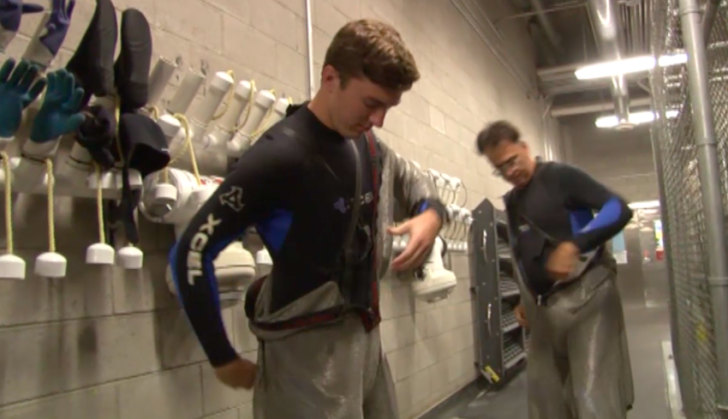
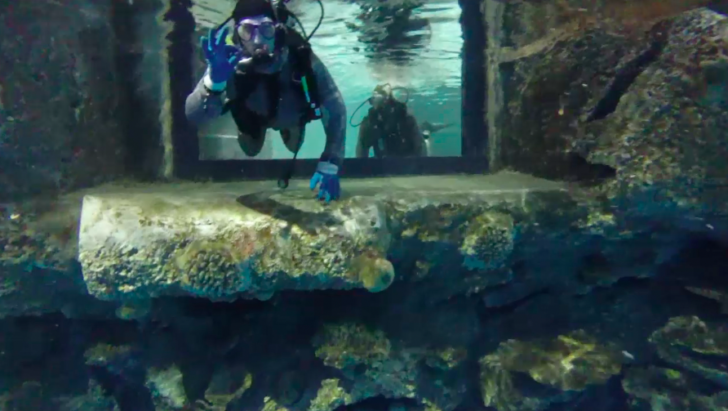
We started off in a small pool four feet deep to check equipment before our assistant raised the gate and let us into the main shark tank. The adventure was beginning! Check out this video of our dive. I’ve edited it slightly to remove the names of other divers for privacy reasons. I’m still learning how to use iMovie and will see if I can edit it further — I know 15 minutes is long for most people, but I was down there for about an hour and loved every minute!
Our dive consisted of moving from one side of the tank to another, then waiting quietly until the animals became comfortable with our presence and swam over to investigate. Or rather, we investigated them. The sharks mostly did circuits of the tank. The point was that they were no longer avoiding us and so we could get closer than I’d ever thought possible. Sometimes I’d roll around on my back and see a giant ray or shark passing right over me. A few times I even bumped heads with a shark!
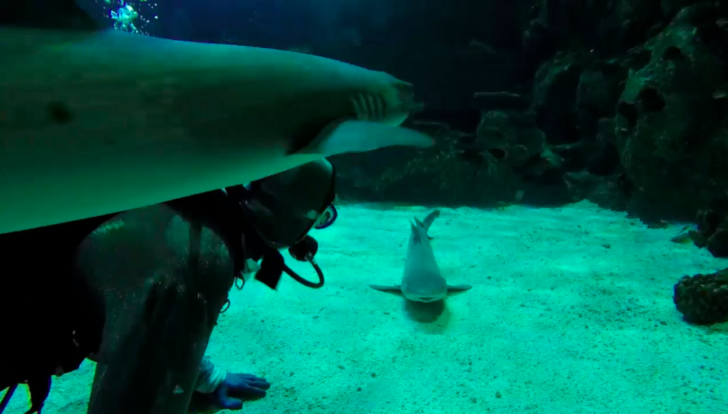
Sharks have lots of teeth — rows and rows of them that they are constantly losing and replacing. So we stopped in a corner and sifted through the sand to find a few souvenirs to take home. 😉 As our guide said, once you know what to look for they are actually pretty easy to find. By this point we were getting tons of attention from the visitors on the other side of the glass. We swam over and waved, showed the kids a few of the teeth, and just in general made them excited to learn more about sharks and the world below the surface.
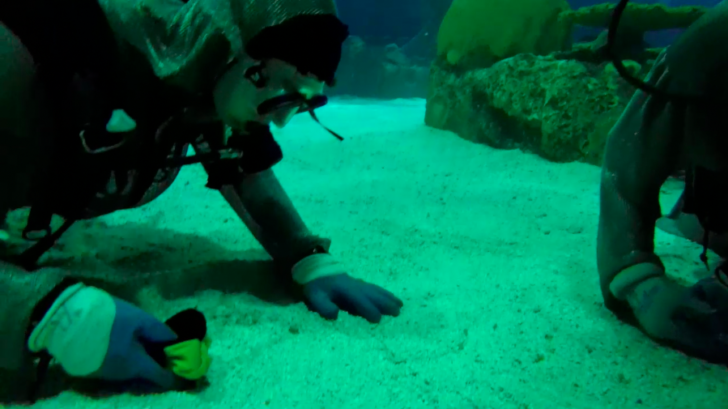
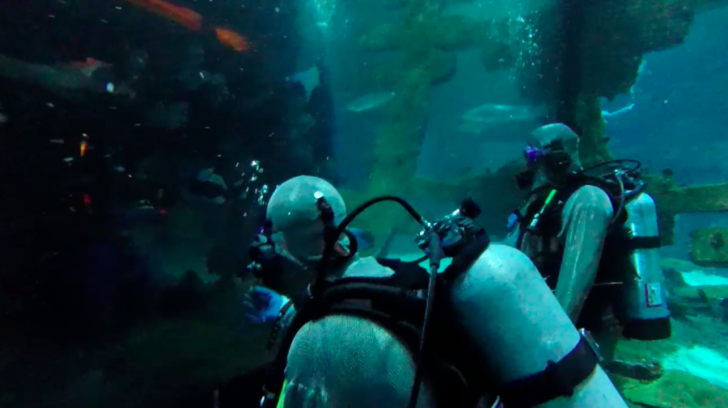
We also got to swim under the viewing gallery. There were a few large sharks hanging around, out of sight. Then up, over the tunnel, and back to a corner to watch more sharks.
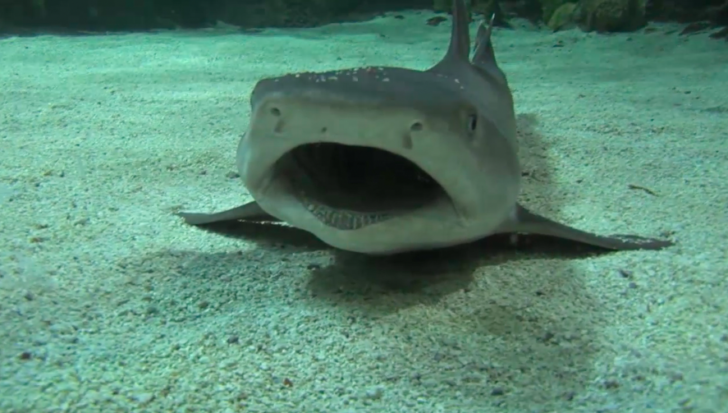
The dive seemed to stretch out for a while. Unlike a dive in the open where you can visit lots of new territory, we were limited to the confines of a (very large) tank. You can’t see the edge of the tank from the viewing area, making it look like the depths stretch on forever, but on the other side the walls are more obvious. But I didn’t care. I was surrounded by dozens of sharks!
Soon enough it was time to go back to the surface. We went back into the secure area, dropped the gate behind us, and dragged ourselves out of the water. That chainmail suit was suddenly very heavy again. But there were no emergencies, I was still in one piece, and in addition to some pictures and video I have pretty amazing memories. Hopefully soon enough I’ll have another chance to swim with sharks in the wild!
If you want to try Mandalay Bay’s Dive with Sharks experience yourself, it’s available by reservation for $650 for individuals or $1,000 for two people. The experience includes a guided tour and an approximately one-hour dive accompanied by a dive master and videographer.

